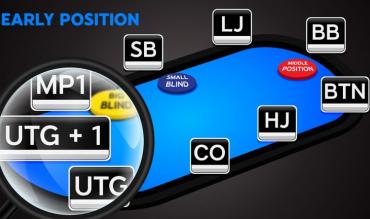This basic guide will layout our strategic outlook when playing in the early positions of a FR (full ring) table. We’ll select examples from NLHE cash games, but many of the concepts will translate into other formats such as tournaments or PLO.
On a ten-handed table, the early positions are UTG, UTG+1 and UTG+2. For the sake of this discussion, we will also include the next position MP1 (although this is technically classed as middle-position).
Strategically there is not a large amount of difference between these four spots, although we will be able to play slightly wider ranges in the later the position. All of these four positions are unique to FR games.
Table of Contents
The Early Positions – An Overview
Let’s recap on the key features of the early positions in FR.
- The four earliest positions in full ring games.
- Expecting to steal the blind is highly optimistic with 6-9 players in front of us.
- We face very strong open raising ranges.
- We are extremely likely to be out of position postflop.
Put simply, players should not expect to generate a large amount of profit from these seats. The fundamental objective here is to wait for premium holdings only.
When allowed to open-raise, the raising frequency depends on the exact position. MP1 will typically seek to raise about 11% of holdings while UTG will look to raise around 7% of holdings. It’s difficult to play more aggressively than this due to the ever-present threat of 3bets and cold calls from the players who have position on us.
Although open raising is the most profitable early position scenario, we have the option to attack open raises from the earlier positions either by cold calling or 3betting. It’s also difficult to play too aggressively in this scenario however since -
- Our cold calls can easily get squeezed or overcalled by any player who has position on us.
- Even if we 3bet any player who has position on us may elect to cold-4bet preflop.
- Since we are playing against UTG+2 and earlier, we are typically facing a very strong opening range.
- As such, cold calling and 3betting will not be a large part of our strategy.
Strategic Outlook in EP
Understand that we are not involved in the action unless we pick up a premium.
Stats:
Recommended average cold call frequency: Around 3%
Recommended average 3bet frequency: Around 3%
Recommended raise first in frequency: Between 7 and 11%
(Remember that these stats account for a range of different open sizings)
Sample Ranges From the EARLY POSITIONS
In this section, we’ll look at some sample ranges from the early positions, so that we can get a basic understanding of what to call/fold/raise with from this position.
EP Defence vs EP Open
Purple: Re-raise (3bet) range
Blue: Cold calling range
We will assume that our defending strategy doesn’t change too much depending on the position of the opener. Although it’s true that our defending range won’t change a lot when facing different positions, we should technically play wider vs later positions.
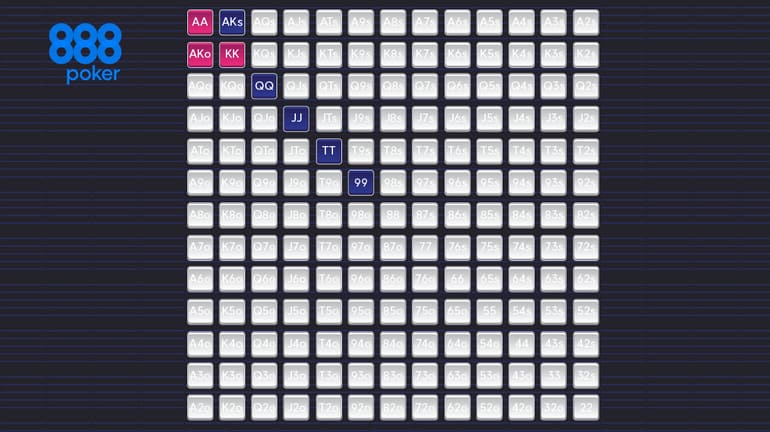
This graph is a sample range for defending against an early position 3bb open-raise. If our opponent open raises smaller, we should protect wider, but more on that later. Note that the 3bet (re-raise) range is heavily weighted towards high equity holdings. It makes sense, not to 3bet bluff speculative holdings in the majority of games since players are not folding as much as they are supposed to when facing 3bets.
MP1 Raise First In Range
“Raise first in” means to open-raise preflop after it gets folded around to us. It’s essential to remember that we are looking to play premium holdings from this seat only.
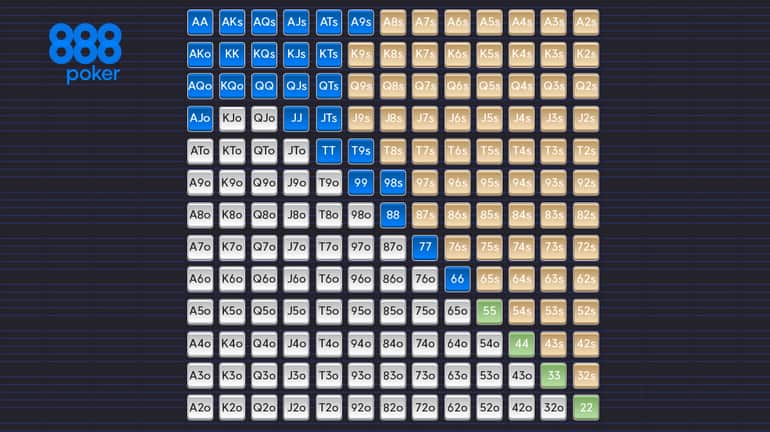
This raising range works out at about 11% of holdings. If we push our aggression beyond this, good players behind may find ways to exploit our strategy.
UTG Raise First In Range
Assuming we are in UTG, we will open an even tighter range of holdings. UTG+1 and UTG+2 will open ranges somewhere in the middle of these two extremes.
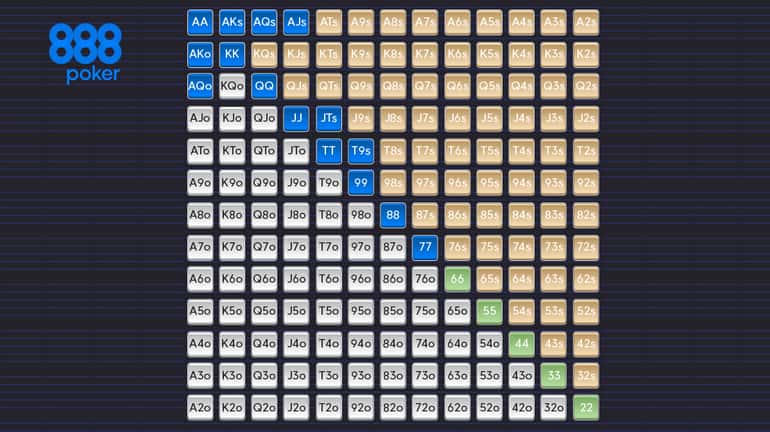
This raising range works out at about 11% of holdings. If we push our aggression beyond this, good players behind may find ways to exploit our strategy.
LJ vs Blinds 3bet
When open raising from EP, we are going to run into 3bets simply because there are so many players behind us. Our response will depend on whether the 3bet comes from the blinds or the BTN/CO/HJ. The following sample range gives us an idea regarding what we should call and what we should re-raise (4bet) when facing a 3bet from the blinds.
Blue = Call vs 3bet
Purple = Re-raise (4bet) vs 3bet
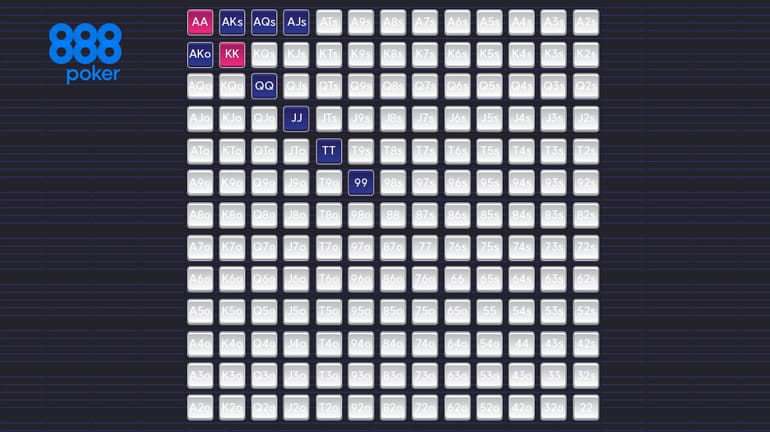
Note that we tend towards re-raise (4betting) with high equity hands only. 4bet bluffing is not incentivised in most environments since the average villain does not fold as much as they are supposed to vs 4bets. This range is about as tight as our defending will get. If we are in MP1 instead of UTG, we can protect slightly wider.
Assuming the 3better is on the BTN/CO rather than in the blinds and we are opening from UTG we should look to respond with a tighter range.
Blue = Call vs 3bet
Purple = Re-raise (4bet) vs 3bet
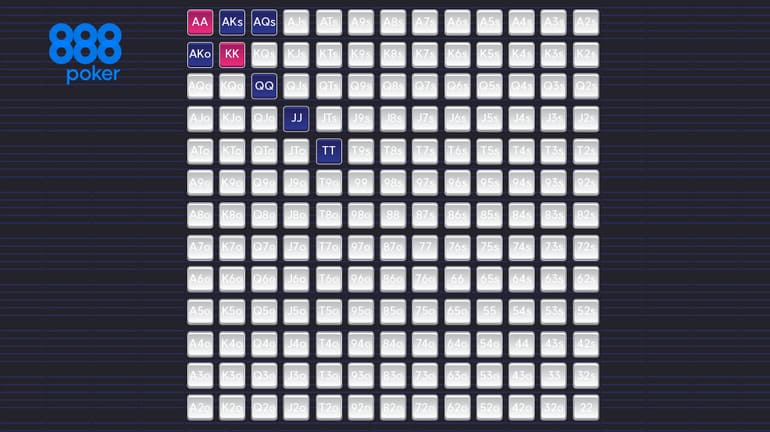
Relevant Adjustments
It’s crucial to understand that the sample ranges should be used as a rough guide rather than a set rule. In practice, we will end up changing these defending ranges based on several variables. A good understanding of these variables will help us to make high-quality decisions on the fly.
Villain’s sizing – The larger our opponent’s open raise (or 3bet) sizing, the tighter we defend.
Formation – The later our opponent’s position, the wider we can defend. We’ll be defending a tight range either way in the early FR positions, however.
Reads – E.g. our opponent folds too much to 3bets/4bets, we can 3bet/4bet more aggressively.
Villain skill - If our opponent is a bad player, we can play more hands in general. Expansion from the early full ring positions will be highly limited either way.
Open raises – If the players behind fold too much or are weak players ,we can slightly expand our raise first in range. The effect of this is minimal from the early full ring positions.
Other Scenarios
Iso Raising – This situation is where we raise from the early positions when facing an open-limp. Since there are quite a number of players still to act behind us, we can only push our iso-raising strategy so wide even if we think villain is a highly profitable target.
Our iso raising ranges will be very similar to our raise first in ranges from these seats but weighted more towards high equity holdings (i.e. big cards instead of suited connectors).
Note: iso raising from these seats is only possible in a full ring game since it is the earliest position in short-handed games.
Iso-raise – A preflop raise made against a limper.
Overcalling/Squeezing – Overcalling and squeezing are terms which refer to 3-way scenarios. When facing two opponents, we generally prefer to 3bet (squeeze) a tighter range and weight our calls (overcall) towards speculative hands with good suited/connected potential.
Note: squeezing and overcalling from these seats is ONLY possible on full ring tables.
Overcall – A call after a player has already called before us on the current street.
Squeeze – A 3bet made after there has already been at least one caller vs an open raise.
Unlike the later positions, overcall/squeeze ranges from early will be remarkably similar to the 3bet/cold-call ranges we are using when facing one opener. This scenario is also somewhat rare, so having separate strategies is not critical in most games.
